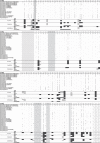Genetic structure and contrasting selection pattern at two major histocompatibility complex genes in wild house mouse populations
- PMID: 20823902
- PMCID: PMC3186229
- DOI: 10.1038/hdy.2010.112
Genetic structure and contrasting selection pattern at two major histocompatibility complex genes in wild house mouse populations
Abstract
The mammalian major histocompatibility complex (MHC) is a tightly linked cluster of immune genes, and is often thought of as inherited as a unit. This has led to the hope that studying a single MHC gene will reveal patterns of evolution representative of the MHC as a whole. In this study we analyse a 1000-km transect of MHC variation traversing the European house mouse hybrid zone to compare signals of selection and patterns of diversification at two closely linked MHC class II genes, H-2Aa and H-2Eb. We show that although they are 0.01 cM apart (that is, recombination is expected only once in 10 000 meioses), disparate evolutionary patterns were detected. H-2Aa shows higher allelic polymorphism, faster allelic turnover due to higher mutation rates, stronger positive selection at antigen-binding sites and higher population structuring than H-2Eb. H-2Eb alleles are maintained in the gene pool for longer, including over separation of the subspecies, some H-2Eb alleles are positively and others negatively selected and some of the alleles are not expressed. We conclude that studies on MHC genes in wild-living vertebrates can give substantially different results depending on the MHC gene examined and that the level of polymorphism in a related species is a poor criterion for gene choice.
Figures




Similar articles
-
Selection, diversity and evolutionary patterns of the MHC class II DAB in free-ranging Neotropical marsupials.BMC Genet. 2008 Jun 5;9:39. doi: 10.1186/1471-2156-9-39. BMC Genet. 2008. PMID: 18534008 Free PMC article.
-
Balancing selection and recombination as evolutionary forces caused population genetic variations in golden pheasant MHC class I genes.BMC Evol Biol. 2016 Feb 18;16:42. doi: 10.1186/s12862-016-0609-0. BMC Evol Biol. 2016. PMID: 26892934 Free PMC article.
-
Molecular evolution at Mhc genes in two populations of chinook salmon Oncorhynchus tshawytscha.Mol Ecol. 1997 Oct;6(10):937-54. doi: 10.1046/j.1365-294x.1997.00274.x. Mol Ecol. 1997. PMID: 9348703
-
Major Histocompatibility Complex (MHC) Genes and Disease Resistance in Fish.Cells. 2019 Apr 25;8(4):378. doi: 10.3390/cells8040378. Cells. 2019. PMID: 31027287 Free PMC article. Review.
-
Meta-analysis of major histocompatibility complex (MHC) class IIA reveals polymorphism and positive selection in many vertebrate species.Mol Ecol. 2022 Dec;31(24):6390-6406. doi: 10.1111/mec.16726. Epub 2022 Oct 19. Mol Ecol. 2022. PMID: 36208104 Free PMC article. Review.
Cited by
-
MHC class IIB exon 2 polymorphism in the Grey partridge (Perdix perdix) is shaped by selection, recombination and gene conversion.PLoS One. 2013 Jul 23;8(7):e69135. doi: 10.1371/journal.pone.0069135. Print 2013. PLoS One. 2013. PMID: 23935938 Free PMC article.
-
MHC Genotyping by SSCP and Amplicon-Based NGS Approach in Chamois.Animals (Basel). 2020 Sep 18;10(9):1694. doi: 10.3390/ani10091694. Animals (Basel). 2020. PMID: 32962183 Free PMC article.
-
Evolutionary genetics of MHC class II beta genes in the brown hare, Lepus europaeus.Immunogenetics. 2011 Nov;63(11):743-51. doi: 10.1007/s00251-011-0539-3. Epub 2011 Jun 18. Immunogenetics. 2011. PMID: 21688061 Free PMC article.
-
Contrasting patterns of polymorphism and selection in bacterial-sensing toll-like receptor 4 in two house mouse subspecies.Ecol Evol. 2014 Jul;4(14):2931-44. doi: 10.1002/ece3.1137. Epub 2014 Jun 20. Ecol Evol. 2014. PMID: 25165529 Free PMC article.
-
Reconstructing Macroevolutionary Patterns in Avian MHC Architecture With Genomic Data.Front Genet. 2022 Feb 17;13:823686. doi: 10.3389/fgene.2022.823686. eCollection 2022. Front Genet. 2022. PMID: 35251132 Free PMC article.
References
-
- Alcaide M, Edwards SV, Negro JJ. Characterization, polymorphism, and evolution of MHC class II B genes in birds of prey. J Mol Evol. 2007;65:541–554. - PubMed
-
- Babik W, Durka W, Radwan J. Sequence diversity of the MHC DRB gene in the Eurasian beaver (Castor fiber) Mol Ecol. 2005;14:4249–4257. - PubMed
-
- Babik W, Pabijan M, Radwan J. Contrasting patterns of variation in MHC loci in the Alpine newt. Mol Ecol. 2008;17:2339–2355. - PubMed
-
- Barton NH, Hewitt GM. Analysis of hybrid zones. Annu Rev Ecol Syst. 1985;16:113–148.
Publication types
MeSH terms
Substances
LinkOut - more resources
Full Text Sources
Research Materials

